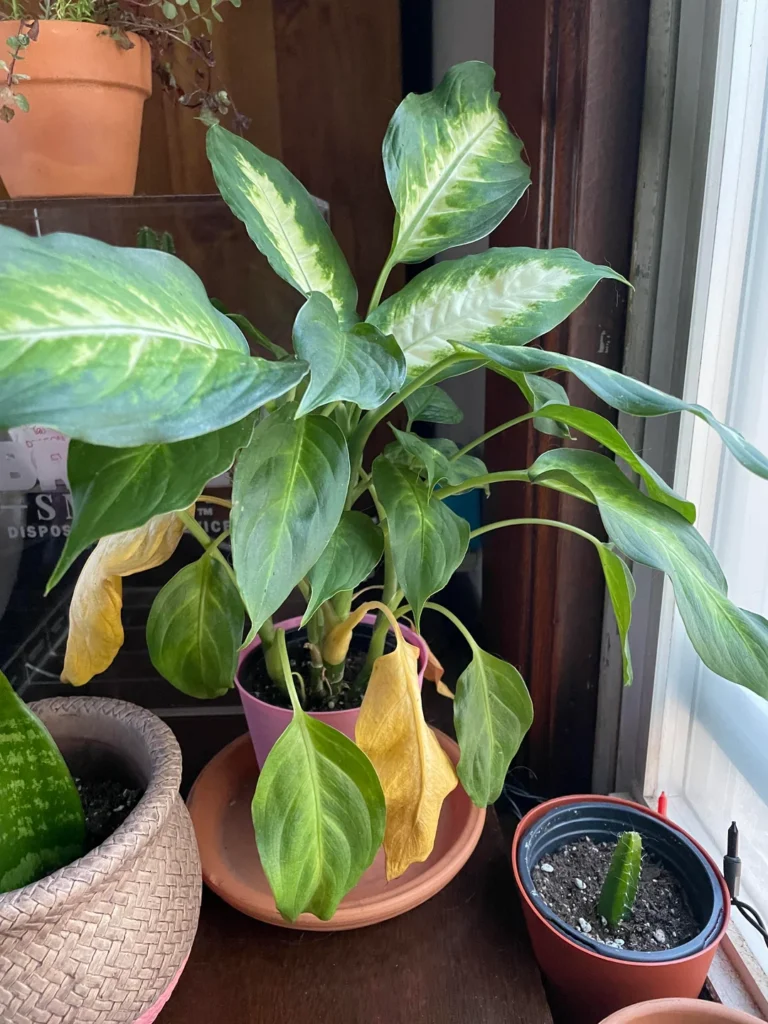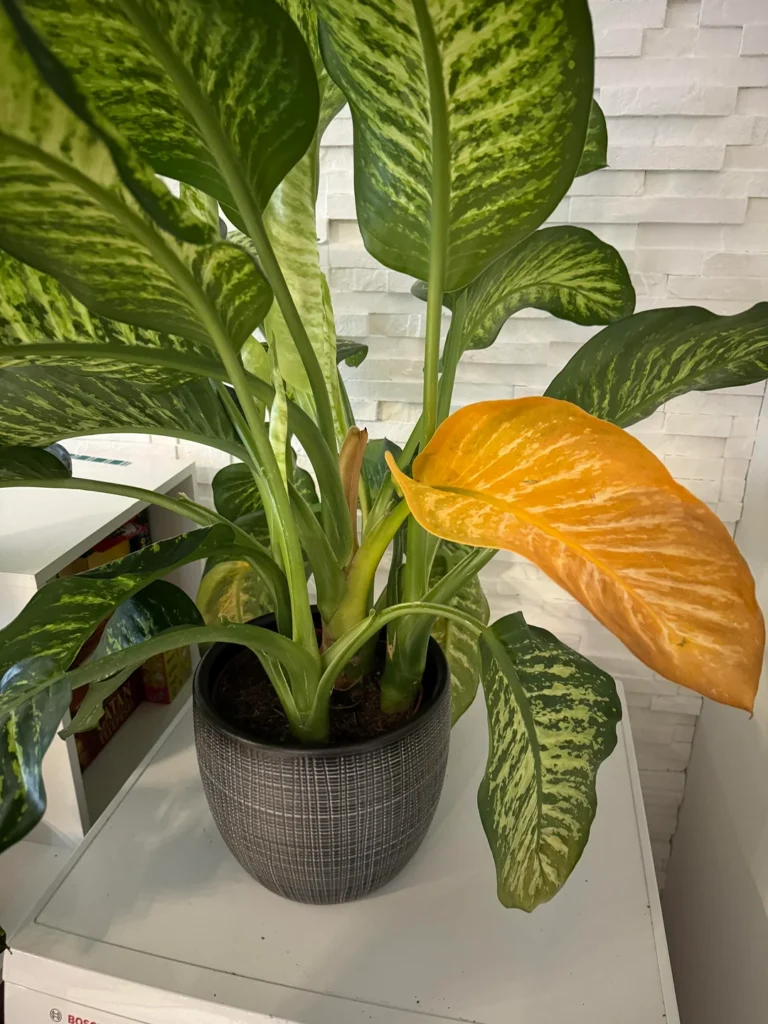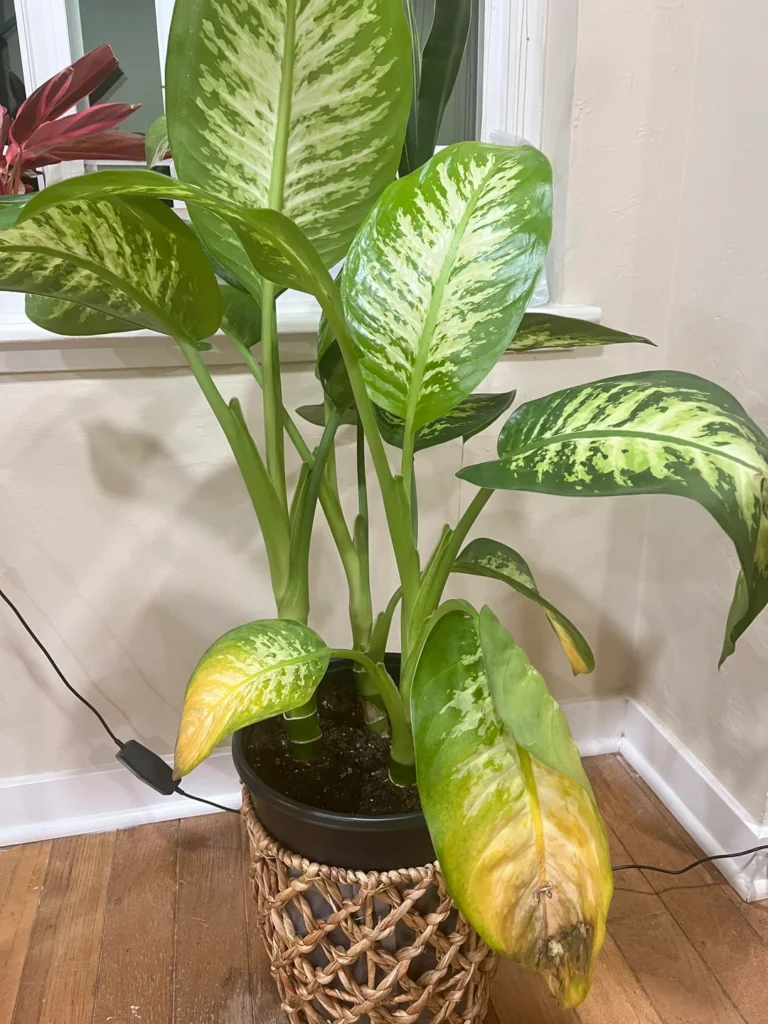Why Dieffenbachia Plant Gets Yellow Leaves: Top Causes and Fixes
Dieffenbachia plants are known for their lush green leaves, but yellow leaves can be a common issue. 🌿
One reason this happens is because older leaves naturally turn yellow and fall off as new growth emerges. Often, this process is normal and not a cause for alarm.
Sometimes, yellow leaves point to a problem like overwatering or underwatering. If the soil is too wet, the roots might rot, leading to yellowing leaves.
Check the soil and adjust your watering routine to keep your plant happy. 💧
Pests and diseases can also make leaves turn yellow. Bugs like mealybugs or spider mites can stress the plant out.
Have you ever spotted tiny pests on your plant? Regularly inspecting both sides of the leaves can help you catch these issues early. Share your experiences and tips in the comments below! 🐜👇

Please note: Simplify Plants is reader-supported. As an Amazon Associate, I earn from qualifying purchases made by our readers with no extra cost added to you all! Some links in the post are affiliate links and I get a commission from purchases made through links in the post.
Basics of Dieffenbachia Care
Taking care of your Dieffenbachia plant involves paying close attention to watering habits, providing the right lighting, and ensuring suitable temperature and humidity levels.
Let’s dive into the essentials to keep your plant healthy and green! 🌿
Optimal Watering Practices
Watering Dieffenbachia correctly is like Goldilocks finding that “just right” balance.
Too much water, and the plant’s roots drown, leading to yellow leaves. Too little water, and the leaves droop and turn yellow.
A good rule of thumb is to water the plant when the top inch of soil feels dry. You can poke your finger into the soil to check it.
Don’t let the plant sit in water; drainage is essential!
Use pots with good drainage holes and never let the bottom of the pot sit in water.
Overwatering is a common mistake, so be cautious not to drown your plant. 🌱💧
Appropriate Lighting Conditions

Dieffenbachia plants thrive in bright, indirect light.
Direct sunlight can scorch the leaves and cause them to turn yellow. I usually place my plant near a north or east-facing window where it gets enough light without the harsh sun rays.
If you notice the leaves getting too pale, it might be a sign that it needs a little more light.
In darker corners, you might use a grow light to give your Dieffenbachia the boost it needs.
Remember, consistent light is key to keeping your plant happy and healthy! 🌞🪴
Suitable Temperature and Humidity
Dieffenbachia prefers warm temperatures, between 65°F and 75°F (18°C to 24°C).
Cold drafts or sudden temperature changes can stress the plant, causing yellow leaves. Avoid placing it near windows or doors where cold air might seep through.
Humidity is also crucial; these plants love a bit of moisture in the air.
If your home is dry, consider using a pebble tray or a humidifier to maintain the right humidity levels. Misting the leaves occasionally can also help, but don’t overdo it, as too much moisture can encourage mold growth.
Common Causes of Yellow Leaves
Yellow leaves on a Dieffenbachia plant can be caused by a few different factors. Let’s explore some of the main reasons your plant might be struggling and how to fix them.
Overwatering Issues

Overwatering is one of the most common reasons for yellow leaves. When I notice the soil is constantly wet, it’s a sign that the plant is getting too much water.
This can cause the roots to rot and lead to yellow leaves. 🌿
To fix this, I let the soil dry out before watering again. I also make sure to water less frequently. If the soil is overly compacted, it might be time to repot the plant with fresh soil. Is your Dieffenbachia also feeling the effects of too much water? 😅
Poor Drainage
Even if I water my plant correctly, poor drainage can still cause problems. Without proper drainage, water can pool at the bottom of the pot, keeping the roots wet and leading to yellow leaves.
I ensure that my pot has drainage holes and use a well-draining soil mix. Adding perlite or sand can help improve soil drainage. Checking the bottom of the pot for standing water can also prevent issues. Have you checked your plant’s pot lately? 🌱
Nutrient Deficiencies
A lack of nutrients can make the Dieffenbachia’s leaves turn yellow.
When the plant doesn’t get enough essential nutrients like nitrogen, the leaves can change color and look unhealthy. 😕
I use a balanced, water-soluble fertilizer to keep my plant healthy.
Fertilizing every 4-6 weeks during the growing season helps prevent deficiencies. If the leaves are still yellow, I might try a specific nutrient supplement. Is your plant getting enough food?
Pest Infestations

Pesky bugs can also cause yellow leaves. Spider mites, aphids, and other pests suck the sap from the leaves, causing damage and discoloration.
I keep an eye out for small insects or webbing on the plant. 🐛
If I find pests, I use a mild insecticidal soap or neem oil to treat the plant. Regularly checking the plant and keeping it clean helps prevent infestations. Have you seen any unwelcome guests on your Dieffenbachia?
Troubleshooting Yellow Leaves
If your Dieffenbachia leaves are turning yellow, don’t worry! 🪴
Let’s dive into some common issues you might be facing and how to fix them. This guide will help you assess your watering habits, check your soil quality, and evaluate light exposure.
Assessing Watering Habits
One of the most common reasons for yellow leaves is improper watering.
Overwatering can lead to root rot. Trust me, this is bad news for your Dieffenbachia.
When you overwater, the roots can’t breathe, and they start to rot, causing yellow leaves.
On the flip side, if you’re underwatering, the plant isn’t getting enough moisture, leading to dry, yellow leaves.
The key? Consistency.
Water the soil when it’s dry about an inch deep. Use your finger to check before watering. Not sure how much to water? Try a moisture meter!
Checking Soil Quality

Soil quality matters a lot for Dieffenbachia. If the soil doesn’t drain well, excess water can cause root damage.
Choose a well-draining potting mix—something with perlite or sand works well. 🌱
Poor soil quality can also mean a lack of nutrients.
If your plant isn’t getting enough nourishment, it can get weak, causing the leaves to yellow.
I recommend a balanced, slow-release fertilizer every couple of months. This will keep your plant happy and healthy.
Quick tip: If your plant has been in the same soil for years, it might be time for a change. Fresh soil means fresh nutrients!
Evaluating Light Exposure
Dieffenbachia plants love bright, indirect light.
Too much direct sunlight can scorch the leaves, turning them yellow. If your plant is near a south-facing window, the intense sunlight might be too much.
Instead, place it somewhere with soft, diffused light.
On the other hand, too little light can also cause problems.
If your home is a bit on the darker side, consider moving your plant closer to a light source or using a grow light.
Ever notice how plants seem to lean towards the light? They’re not just being dramatic! They need adequate light to thrive. ✨
Preventative Measures for Healthy Leaves
To keep your Dieffenbachia leaves vibrant and healthy, you need to focus on regular care, proper fertilization, and pest control. These practices will help your plant thrive and avoid the yellowing of its leaves.
Regular Maintenance Tips
Watering Schedule: Keep the soil consistently moist but not soggy. Overwatering and underwatering can both cause yellow leaves. I check my plant’s soil once a week to see if it needs watering.
Proper Light: Dieffenbachia loves bright, indirect light. Direct sunlight can burn the leaves, while too little light can cause them to yellow. I keep mine near a window with filtered sunlight.
Pruning: Remove any dead or yellowing leaves to encourage new growth. Pruning also helps the plant focus its energy on healthy leaves and stems.
Fertilization Guidelines

Balanced Nutrients: Use a balanced, water-soluble fertilizer every 4-6 weeks during the growing season. This keeps the plant nourished and prevents nutrient deficiencies that can cause yellowing.
Dilution is Key: Make sure to dilute the fertilizer to half the recommended strength to avoid over-fertilizing, which can harm the plant.
Slow Down in Winter: In the colder months, reduce fertilization. Dieffenbachia’s growth slows during winter, and too much fertilizer can lead to problems.
Pest Prevention Strategies
Regular Checks: Inspect your plant’s leaves regularly for pests like spider mites, mealybugs, and scale insects. Early detection makes treatment easier.
Cleaning Routine: Wipe the leaves with a damp cloth every few weeks. This removes dust and can help you spot any pests early.
Natural Remedies: If you spot pests, use natural remedies like neem oil or insecticidal soap. These are safe and effective ways to keep your Dieffenbachia pest-free.
Advanced Care Techniques
Taking dieffenbachia plant care to the next level involves making seasonal adjustments, amending soil, and repotting when needed. These steps help keep your plant thriving year-round. 🌱
Seasonal Adjustments
Dieffenbachia plants need different care throughout the year.
For example, during the spring and summer months, they love bright, indirect light and plenty of humidity. If your home is dry, you might want to mist the leaves or use a humidifier.
In the colder months, water less frequently because the plant’s growth slows down.
Make sure not to place the plant near drafty windows or heating vents, as extreme temperature changes can stress it out. Have you noticed yellow leaves during the winter? This might be the reason.
Soil Amendments

Healthy soil is crucial for a thriving dieffenbachia.
I mix in some perlite or orchid bark to ensure that the soil drains well. This prevents water from sitting around the roots and causing problems like root rot, which can lead to yellow leaves. A good blend might be half regular potting soil and half perlite or bark.
You can also add some slow-release fertilizer during the growing season. This ensures that your plant gets a steady supply of nutrients. Is your dieffenbachia looking a little sad? A soil amendment could be the boost it needs.
Repotting Best Practices
Even the healthiest plants need a new home now and then. I repot my dieffenbachia every one to two years.
When you see roots starting to poke out from the bottom of the pot, it’s a sign the plant needs more space.
Choose a pot that’s about 1-2 inches larger in diameter than the current one.
Be gentle when removing it from the old pot, and shake off excess soil from the roots.
After placing it in the new pot, fill in with fresh soil and water lightly. 😃
Repotting not only gives the plant more room to grow but also refreshes the soil, which can get compacted over time.
Got questions or tips on advanced dieffenbachia care? Drop them in the comments below! 🌿👩🌾
FAQs
Why are my Dieffenbachia’s leaves turning yellow?
There are a few reasons why this might happen. Overwatering, underwatering, pests, lack of nutrients, or even normal aging can cause yellow leaves. 🪴
How can I tell if it’s overwatering or underwatering?
If the soil is soggy, it’s probably overwatering. If it’s dry and crumbly, the plant needs more water.
Can pests be a reason?
Yes, pests like spider mites and mealybugs can make leaves turn yellow. Check under the leaves and around the stems.
Is yellowing of Dieffenbachia leaves due to age normal?
Yes! As the plant ages, it’s common for the lower leaves to turn yellow and fall off. It’s a sign of new growth coming in.
What should I do if pests are the problem?
First, isolate the plant to prevent the pests from spreading. Then, carefully clean the leaves with soapy water or use an appropriate pesticide.
Could poor lighting cause yellow leaves?
Yes, Dieffenbachias need indirect light. Too much direct sunlight can scorch the leaves, while too little light can make them yellow.
How often should I fertilize my Dieffenbachia?
Once a month during the growing season (spring and summer) is usually enough. Use a balanced fertilizer.
What if my plant has root rot?
If you suspect root rot, gently remove the plant from its pot and check the roots. Cut away any mushy, black roots and repot in fresh, well-draining soil.
Do you have more questions or some plant tips to share? Drop a comment below! 🌿😊
Conclusion
Yellow leaves on my Dieffenbachia can be a bummer 😕, but they usually have a fixable cause.
I’ve found that overwatering is often the culprit. Letting the soil dry out a bit usually helps.
Pests can also play a part. Regularly checking for bugs like mealybugs or spider mites keeps my plant healthy.
Basic plant care like avoiding too much sun or keeping it away from cold drafts makes a huge difference.
Anyone else deal with this? Drop your tips below! 🌿💬
Recommended Garden Supplies
| Product Image | Our Recommended Gardening Supplies | Check Offers! |
|---|---|---|
Top Top
Top
Top
Top
Top
Top
Top
Top | rePotme Houseplant and Tropical Classic Potting Soil Mix | Check Offer On Amazon |
 Top
Top
Top
Top
Top
Top
Top
Top | Espoma Organic Indoor Plant Food | Check Offer On Amazon |
 Top
Top
Top
Top
Top
Top
Top
Top | GooingTop LED Grow Light 6000K Full Spectrum Clip Plant Growing Lamp | Check Offer On Amazon |
 Top
Top
Top
Top
Top
Top
Top
Top | Soil Moisture Meter | Check Offer On Amazon |
 Top
Top
Top
Top
Top
Top
Top
Top | Govee Hygrometer Thermometer, Bluetooth Enabled! | Check Offer On Amazon |
 Top
Top | LEVOIT Humidifiers for Large Room(Best For Plants) | Check Offer On Amazon |
 Top
Top
Top
Top
Top
Top
Top
Top | Upgraded DIY Automatic Drip Irrigation Kit, 15 Potted Houseplants Support | Check Offer On Amazon |
 Top
Top
Top
Top
Top
Top
Top
Top | Stainless Steel Heavy Duty Gardening Tool Set | Check Offer On Amazon |
 Top
Top
Top
Top
Top
Top
Top
Top | Bonide Insecticidal Soap | Check Offer On Amazon |
 Top
Top
Top
Top
Top
Top
Top
Top | Bonide 32 oz Spray Neem Oil for Organic Gardening | Check Offer On Amazon |
 Top
Top
Top
Top
Top
Top
Top
Top | Garden Safe Fungicide | Check Offer On Amazon |






